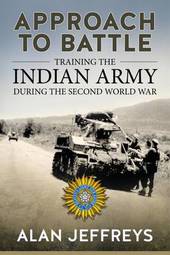
|
Approach to Battle: Training the Indian Army During the Second World War
Hardback
Main Details
| Title |
Approach to Battle: Training the Indian Army During the Second World War
|
| Authors and Contributors |
By (author) Alan Jeffreys
|
| Series | War & Military Culture in South Asia |
|---|
| Physical Properties |
| Format:Hardback | | Pages:249 | | Dimensions(mm): Height 234,Width 156 |
|
| Category/Genre | World history
Second world war |
|---|
| ISBN/Barcode |
9781911096511
|
| Classifications | Dewey:940.541254 |
|---|
| Audience | |
|---|
| Illustrations |
8 maps
|
|
Publishing Details |
| Publisher |
Helion & Company
|
| Imprint |
Helion & Company
|
| Publication Date |
15 December 2016 |
| Publication Country |
United Kingdom
|
Description
The Indian Army was the largest volunteer army during the Second World War. Indian Army divisions fought in the Middle East, North Africa and Italy - and went to make up the overwhelming majority of the troops in South East Asia. Over two million personnel served in the Indian Army - and India provided the base for supplies for the Middle Eastern and South East Asian theatres. This monograph is a modern historical interpretation of the Indian Army as a holistic organisation during the Second World War. It will look at training in India - charting how the Indian Army developed a more comprehensive training structure than any other Commonwealth country. This was achieved through both the dissemination of doctrine and the professionalism of a small coterie of Indian Army officers who brought about a military culture within the Indian Army - starting in the 1930s - that came to fruition during the Second World War, which informed the formal learning process. Finally, it will show that the Indian Army was reorganised after experiences of the First World War. During the interwar period, the army developed training and belief for both fighting on the North West Frontier, and as an aid to civil power. With the outbreak of the Second World War, in addition to these roles, the army had to expand and adapt to fighting modern professional armies in the difficult terrains of desert, jungle and mountain warfare. A clear development of doctrine and training can be seen, with many pamphlets being produced by GHQ India that were, in turn, used to formulate training within formations and then used in divisional, brigade and unit training instructions - thus a clear line of process can be seen not only from GHQ India down to brigade and battalion level, but also upwards from battalion and brigade level based on experience in battle that was absorbed into new training instructions. Together with the added impetus for education in the army, by 1945 the Indian Army had become a modern, professional and national army.
Author Biography
Alan Jeffreys is a curator at the Imperial War Museum and is an expert on tactics and training for jungle warfare and the British Army in the Far East during World War II.
ReviewsAll aspects of training this vast army are described and we commend this ground-breaking book and congratulate Alan on a splendid piece of work. * The Bulletin of the Military Historical Society * This will undoubtedly appeal to anyone interested in how the Indian Army adapted to the many challenges it faced. * Miniature Wargames - Chris Jarvis * This book is diligently researched and accessibly written. It deserves to be a benchmark work in Indian Army historiography and there is much of value and benefit to be drawn for Second World War British Army historians, not just specialists in the Indian Army. Very highly recommended. * Society of Friends of the National Army Museum *
|